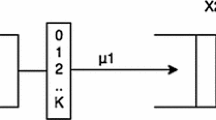Abstract
We consider a tandem production line where the product flowing through the line is continuous fluid. We call such a line a continuous tandem (CT) line. We derive a recursive representation for the departure time of products in CT lines. Next, we apply sample path analysis techniques to prove that the departure time is convex (in the sense of strong stochastic convexity) in the flow rates of the machines. We then prove that the infinitesimal perturbation analysis (IPA) estimate, for the gradient of throughput with respect to machine flow rates, is strongly consistent.
Similar content being viewed by others
References
Buzacott, J. A., and Hanifin, L. E. 1978. Models of automatic transfer lines with inventory banks: A review and comparison. AIIE Transactions 10(2): 197–207.
Dallery, Y., and Gershwin, S. B. 1992. Manufacturing flow line systems: A review of models and analytical results. Queueing Systems: Theory and Applications. Special Issue on Queueing Models of Manufacturing Systems. 12: 3–94.
David, R., Xie, X. L., and Dallery, Y. 1990. Properties of continuous models of transfer lines with unreliable machines and finite buffers. IMA Journal of Mathematics Applied in Business and Industry 6: 281–308.
Fu, B.-R. 1996. Modeling and analysis of discrete tandem production lines using continuous flow models. Ph.D. Thesis. University of Wisconsin-Madison.
Fu, B.-R., Suri, R., and Shi, L. 1996. Analysis of departure times in discrete and continuous tandem production lines. Working paper. University of Wisconsin-Madison.
Fu, M. C., and Hu, J. Q. 1991. Consistency of infinitesimal perturbation analysis for the GI/G/m queue. European Journal of Operational Research 54: 121–139.
Fu, M. C., and Xie, X. 1998. Perturbation analysis of two-stage continuous transfer lines subject to operationsdependent failures. Submitted to the 37th IEEE Conf. on Decision and Control.
Glasserman, P. 1991. Gradient Estimation Via Perturbation Analysis. Kluwer Academic Publishers.
Glasserman, P., and Yao, D. D. 1991. Algebraic structure of some stochastic discrete event systems, with applications. Journal of Discrete Event Dynamic Systems: Theory and Applications 1(1): 7–35.
Glynn, P. W. 1986. Optimization of stochastic systems. Proceedings of the 1986 Winter Simulation Conference, pp. 52–59.
Glynn, P.W. 1987. Likelihood ratio gradient estimation: An overview. Proceedings of the 1987Winter Simulation Conference, pp. 366–374.
Glynn, P. W. 1992. Pathwise convexity and its relation to convergence of time-average derivatives. Management Science 38(9): 1360–1366.
Ho, Y. C. 1987. Performance evaluation and perturbation analysis of discrete event dynamics systems. IEEE Transactions on Automatic Control AC-32(7): 563–572.
Ho, Y. C., and Cao, X.-R. 1991. Perturbation Analysis of Discrete Event Dynamic Systems. Kluwer Academic Publishers.
Hu, J.-Q. 1992. Convexity of sample path performance and strong consistency of infinitesimal perturbation analysis. IEEE Transactions on Automatic Control 37(2): 258–262.
Leung, Y. T. 1990. Single-run optimization of discrete-event simulations. Ph.D. Thesis. University ofWisconsin-Madison.
Lindley, D. V. 1952. On the theory of queues with a single server. Proc. Camb. Philos. Soc. 48: 277–289.
Robinson, S. M. 1995. Convergence of subdifferentials under strong stochastic convexity. Management Science 41(8): 1397–1401.
Shanthikumar, J. G., and Yao, D. D. 1989. Second-order stochastic properties in queueing systems. Proceedings of the IEEE 77(1): 162–170.
Shanthikumar, J. G., and Yao, D. D. 1991. Strong stochastic convexity: Closure properties and applications. Journal of Applied Probability 28(1): 131–145.
Suri, R. 1989. Perturbation analysis: The state of the art and research issues explained via the GI/G/1 queue. Proceedings of the IEEE 77(1): 114–137.
Suri, R., and Fu, B.-R. 1991. On using continuous lines for performance estimation of discrete production lines. Proc. 1991 Winter Simulation Conf., pp. 968–977.
Suri, R., and Fu, B.-R. 1993. Using continuous models to enable rapid analysis and optimization of discrete production lines·A progress report. Proc. 19th Annual NSF Grantees Conf. on Decision and Manufacturing Systems Research. Charlotte, NC.
Suri, R., and Fu, B.-R. 1994. On using continuous lines to model discrete production lines. J. Discrete Event Dynamic Systems: Theory and Applications 4: 129–169.
Suri, R., and Zazanis, M. 1988. Perturbation analysis gives strongly consistent estimates for the M/G/1 queue. Management Science 34: 39–64.
Suri, R., and Leung, Y. T. 1987. Single run optimization of a SIMAN model for closed loop flexible assembly systems. Proceedings of the 1987 Winter Simulation Conference, pp. 738–748.
Suri, R., and Leung, Y. T. 1989. Single run optimization of discrete event simulations·An empirical study using the M/M/1 queue. IIE Transactions 21(1): 35–49.
Suri, R., Sanders, J., and Kamath, M.1993. Performance evaluation of production networks. Chapter in Handbooks in Operations Research and Management Science 4 (S. C. Graves, A. H. G. Rinnooy Kan and P. H. Zipkin, eds.). Elsevier.
Wei, K. C., Tsao, Q. Q., and Otto, N. C. 1989. Determining buffer size requirements using stochastic approximation methods. Technical Report. SR-89-73. Ford Research.
Author information
Authors and Affiliations
Rights and permissions
About this article
Cite this article
Shi, L., Fu, BR. & Suri, R. Sample Path Analysis for Continuous Tandem Production Lines. Discrete Event Dynamic Systems 9, 211–239 (1999). https://doi.org/10.1023/A:1008345330312
Issue Date:
DOI: https://doi.org/10.1023/A:1008345330312




